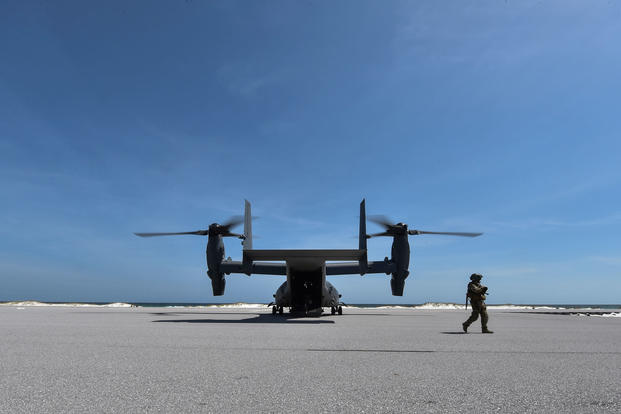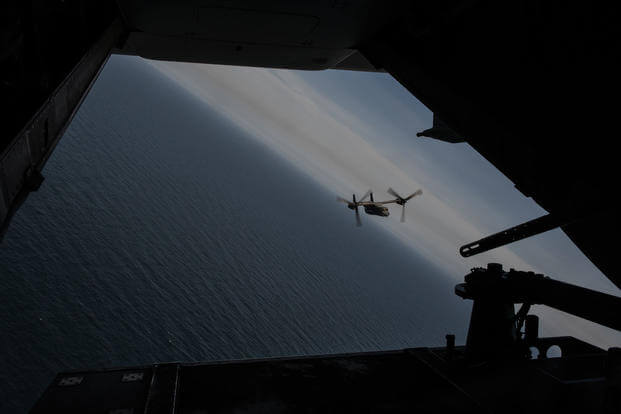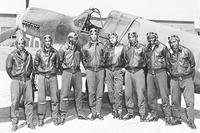For years, officials have wanted a forward firing gun under the Bell-Boeing V-22 Osprey's belly to give it extra defensive measures when landing in an enemy hot zone.
But the rumored addition is still not a done deal, according to Bell-Boeing officials.
"There are some studies and development programs underway for an advanced firing weapon and electronic weapons packages," Chris Gehler, vice president and program director for the V-22 at Bell, told Military.com on Tuesday. [But] the "forward-firing weapon is not [coming] within the next several years; it would probably be just beyond that."
In 2015, Bell-Boeing demonstrated forward-firing rockets, Gehler said. In April, the company did demonstrations for the Marine Corps and Air Force "with some virtual" simulation of a belly system forward-firing gun. However, there is no program of record for the weapon.
Related content:
- Future V-22 Weapons May Range from Lasers to Sonic Waves
- Remains of 3 Marines Killed in Osprey Crash Near Australia Recovered
- New System Will Allow Ospreys to Refuel F-35s in Flight
The desired gun would retract and extend to provide suppressive fires as extra protection on landing or takeoff. The caliber is still to be determined, Gehler said.
"I'd take it right now if we could figure it out. But I'd rather have one that actually works, that's good, that meets the mission requirements. Rather good than fast," said Air Force Col. Tom Palenske, commander of the 1st Special Operations Wing.
Military.com interviewed Palenske earlier this month as part of Air Force Secretary Heather Wilson's recent trip to Air Force Special Operations Command at Hurlburt Field, Florida.
"When we go out there, and we bring enough force to put on the ground to make sure we own that [space], we turn that little patch of whatever country we're in into a little patch of America. That way, our guys get in and get out safely," he said, adding the service's version of the aircraft, the CV-22, came in handy during his deployment to Afghanistan seven years ago.
"Some of the times when we'd go in there, we'd get into a gunfight. We weren't welcome in their neighborhood, I guess," said Palenske, referencing how the V-22 faced Taliban fire. He deployed to Afghanistan in 2011 and 2012.
But "we did 107 assaults in 120 days," he added. "At the end of the day, this is a combat airplane. The challenge is, gunfights in the past, you'd have to turn away from it because your gun is on the tail," he said of the .50 cal machine gun on the aircraft's back ramp.
"Now if we put a gun that could do forward firing, if we get engaged, we could continue [to] forward target the guys" enough to clear the area, he said.
Palenske, who enlisted in the Army and was a door gunner on the UH-1N Huey and UH-60 Black Hawk prior to flying the HH-60 Pave Hawk and MH-53 Pave Low in the Air Force, said he was "blessed" to fly the Osprey.
The Osprey's range reduces the requirement for additional refueling. It has a combat radius of 500 nautical miles with one internal auxiliary fuel tank, according to the Air Force.
But its speed -- 200 miles per hour in some cases -- is its major selling point, said Palenske, who trained on the aircraft in 2008.
He said it makes sense to bring in smaller helicopters, depending on mission set, especially in an urban environment. But "if you want to put mass on the objective ... [the Osprey] goes twice as fast if not two-and-a-half times as fast" in comparison to its counterparts.
"I would take this thing into combat 10 times over any helicopter that's available out there," he said of the tiltrotor aircraft.
Osprey Upgrades
Neither Palenske nor Gehler disputed the V-22's checkered history.
Most recently, an MV-22 crashed in August in waters off the east coast of Australia, killing three Marines.
And members of a Navy SEAL team were injured in the "hard landing" of an Osprey in Yemen last year. The aircraft, valued at $70 million, was destroyed.
Without commenting on the varied causes of recent mishaps, Palenske walked back criticism pointing to the aircraft being the issue in each case.
People will pick at the Osprey "because they haven't flown it," he said.
"We have numerous multiple things in the works at any given time to improve the airframe on a micro-level," Gehler said. "But there's nothing that has been found that fundamentally puts the question of tiltrotor, or anything about the capability, in question."
He added, "Anything that is safety is always at the top of the list. But there hasn't been anything that we've found that is a fundamental change that needs to be made."
The V-22 has more than 400,000 operational flight hours under its belt already, Gehler said, with upgrade efforts ongoing or on the immediate horizon.
For example, Naval Air Systems Command -- which oversees the program -- has done incremental upgrades as they become available. NAVAIR last year gave Bell-Boeing $57 million to begin the Common Configuration-Readiness and Modernization (CCRAM) program, which identifies the current 70-plus configurations and streamlines them into 10 or fewer, Gehler said.
The Air Force is modifying its CV-22s, which belong to Air Force Special Operations Command, to its own block upgrade configuration, he said.
Bell-Boeing is also providing new structure and wiring into its nacelles on all versions of the aircraft, Gehler said. Nacelles are the engine casing that enables the rotor to swivel into its vertical position.
"We will be taking old nacelles off aircraft and putting new nacelles that have been redesigned with these features on them for all the aircraft," he said. "The aim here with nacelle improvement is to reduce maintenance man hours."
The nacelle improvement program begins next week for non-recurring engineering development, Gehler said. Continuous production is slated for 2021.
Lasers and Sonic Waves?
Officials have talked about adding emerging capabilities such as a laser to the aircraft to help it survive in a high-end fight.
But both Palenske and Gehler said they'd rather get the basics right first.
"First, you have to have the requirements of what the capability actually is to have it be brought onto the airplane, so I see it as, the potential of a forward-firing [gun] is the first step in adding other type of advanced weapons," Gehler said.
John "Bones" Parker, tiltrotor business development manager for Boeing Co. and a former Marine aviator, told Military.com last year that the development sonic waves as a non-lethal defensive measure was under consideration for the V-22.
Gehler said he wasn't aware of the necessity for such an upgrade.
"Better put your earplugs in if you've got sonic waves. But I think I call shenanigans on that," Palenske added.
-- Oriana Pawlyk can be reached at oriana.pawlyk@military.com. Follow her on Twitter at @Oriana0214.











